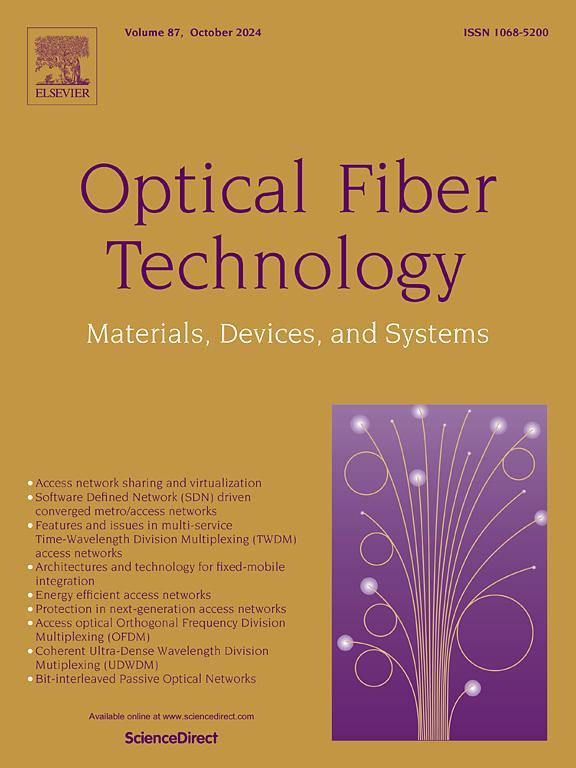Three-layer negative curvature hollow core anti-resonant fiber with low-loss, low dispersion and high manufacturing tolerance in S + C + L band
IF 2.7
3区 计算机科学
Q2 ENGINEERING, ELECTRICAL & ELECTRONIC
引用次数: 0
Abstract
We present a low-loss three-layer negative curvature hollow core anti-resonant fiber (HC-ARF), which exhibits excellent broadband low-loss performance (≤0.135 dB/km) in the entire S + C + L band, with significantly lower chromatic dispersion and polarization mode dispersion. It is worth noting that the effective area of the guided fundamental mode is three times that of conventional single-mode fiber, which means that the designed HC-ARF has a lower nonlinear coefficient and higher power threshold. Furthermore, we conduct an in-depth analysis of the manufacturing tolerance of the designed HC-ARF. Specifically, we investigate the impact on confinement loss (CL) of bending resistance, fiber defects like manufacturing errors in geometric dimensions, embedding depth of the circular tubes, and misalignment between inner tube and other tubes. The obtained results show that the designed three-layer negative curvature HC-ARF has favorable bending resistance and process adaptability, also has a high tolerance for fiber defects that are currently unavoidable in practical fiber manufacturing process. The designed low-loss three-layer negative curvature HC-ARF shows great potential to further reduce the fiber transmission loss and is expected to be applied to various fields such as fiber-optic communications, fiber energy transmission, optical sensing, and nonlinear optics.
S + C + L波段低损耗、低色散、高制造公差的三层负曲率空心抗谐振光纤
我们提出了一种低损耗的三层负曲率空心芯抗谐振光纤(HC-ARF),该光纤在整个S + C + L波段具有优异的宽带低损耗性能(≤0.135 dB/km),色散和偏振模色散显著降低。值得注意的是,导基模的有效面积是传统单模光纤的3倍,这意味着设计的HC-ARF具有更低的非线性系数和更高的功率阈值。此外,我们对所设计的HC-ARF的制造公差进行了深入的分析。具体来说,我们研究了弯曲抗力、纤维缺陷(如几何尺寸制造误差、圆管嵌入深度以及内管与其他管之间的不对准)对约束损耗(CL)的影响。结果表明,所设计的三层负曲率HC-ARF具有良好的抗弯性能和工艺适应性,对目前实际纤维制造过程中不可避免的纤维缺陷具有较高的容忍度。所设计的低损耗三层负曲率HC-ARF显示出进一步降低光纤传输损耗的巨大潜力,有望应用于光纤通信、光纤能量传输、光传感、非线性光学等各个领域。
本文章由计算机程序翻译,如有差异,请以英文原文为准。
求助全文
约1分钟内获得全文
求助全文
来源期刊

Optical Fiber Technology
工程技术-电信学
CiteScore
4.80
自引率
11.10%
发文量
327
审稿时长
63 days
期刊介绍:
Innovations in optical fiber technology are revolutionizing world communications. Newly developed fiber amplifiers allow for direct transmission of high-speed signals over transcontinental distances without the need for electronic regeneration. Optical fibers find new applications in data processing. The impact of fiber materials, devices, and systems on communications in the coming decades will create an abundance of primary literature and the need for up-to-date reviews.
Optical Fiber Technology: Materials, Devices, and Systems is a new cutting-edge journal designed to fill a need in this rapidly evolving field for speedy publication of regular length papers. Both theoretical and experimental papers on fiber materials, devices, and system performance evaluation and measurements are eligible, with emphasis on practical applications.
 求助内容:
求助内容: 应助结果提醒方式:
应助结果提醒方式:


